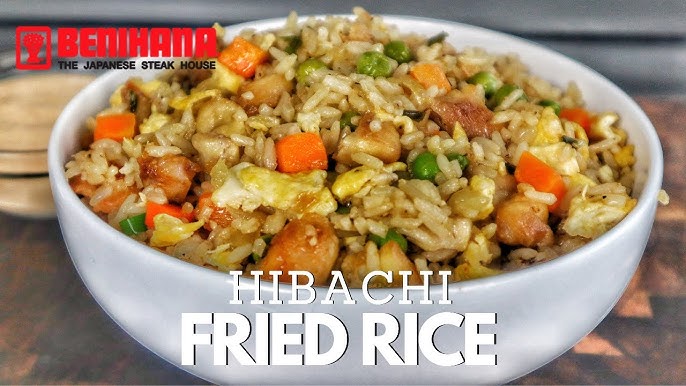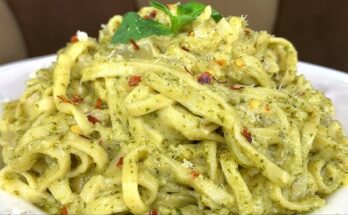Benihana Fried Rice Recipe: Benihana isn’t just another Japanese restaurant—it’s an experience. If you’ve ever sat around one of their hibachi grills, watching chefs flip shrimp tails into their hats and set onions ablaze into volcanoes, then you know the food isn’t the only star of the show. But let’s be honest—everyone secretly comes for that irresistible fried rice. Perfectly seasoned, buttery, and with just the right amount of crunch, Benihana’s fried rice is on another level. It’s so simple, yet undeniably delicious.
The good news? You don’t need a teppanyaki table or a trained chef to bring that magic home. This recipe breaks down every step so you can recreate that restaurant-style fried rice in your own kitchen, with ingredients you probably already have. Whether you’re trying to impress guests or just want to treat yourself, this dish is a guaranteed crowd-pleaser.
Ingredients You’ll Need
Getting Benihana-style fried rice right starts with having the correct ingredients. The beauty of this dish is that it uses everyday staples, but when combined with the right techniques, it transforms into something extraordinary.
Main Ingredients
Here’s what you’ll need for the base of your fried rice:
- Cooked rice (preferably day-old): About 3 cups. Day-old rice is crucial because it’s drier and gives that perfect fried rice texture.
- Eggs: 2 large ones, scrambled separately for that authentic teppanyaki style.
- Vegetables: A mix of finely chopped onions, carrots, and green peas. You can use fresh or frozen veggies.
- Protein (optional): Benihana typically offers chicken fried rice, but feel free to substitute with shrimp, beef, or even tofu.
Seasonings and Sauces
This is where the signature flavor comes from:
- Garlic butter: The heart and soul of Benihana fried rice. You’ll make this from scratch with butter, garlic, and a hint of soy sauce.
- Soy sauce: For umami and saltiness. Light soy sauce works best to not overpower the dish.
- Sesame oil: Just a dash adds a nutty aroma and taste that makes the dish smell like the restaurant version.
- Salt and pepper: To taste, but don’t overdo it—soy sauce already adds saltiness.
Optional but recommended:
- Scallions: Thinly sliced for garnish.
- Sesame seeds: Lightly toasted to sprinkle on top for added crunch.
Tools and Equipment Required
While you don’t need a giant teppanyaki grill like at Benihana, having the right tools will make your cooking smoother and closer to the real thing.
- Non-stick frying pan or large skillet: Cast iron works great too if you want that slightly crispy edge.
- Wok (optional): If you’ve got one, even better! It helps in tossing everything evenly and gives that authentic stir-fry effect.
- Spatulas: A wooden or silicone spatula is ideal so you don’t damage your pan.
- Mixing bowls: For holding pre-chopped veggies, scrambled eggs, and protein.
- Rice paddle or spoon: For fluffing up the rice without mashing it.
Make sure everything is prepped and ready before you start cooking—this dish comes together quickly, and there’s no time to chop mid-way.
Prepping for the Perfect Fried Rice
Preparation is half the battle when it comes to making fried rice. This isn’t one of those recipes where you can freestyle as you go. Timing, temperature, and texture matter.
Use Day-Old Rice
This is non-negotiable. Freshly cooked rice is too soft and moist, which will result in clumpy, soggy fried rice. Let your rice rest in the fridge overnight. The cold air dries it out just enough to create those separate, chewy grains you want.
If you forgot to make rice a day in advance (we’ve all been there), spread freshly cooked rice on a baking sheet and pop it in the freezer for 20-30 minutes. It won’t be exactly the same, but it’ll help dry out the rice quickly.
Chopping and Prepping Ingredients
Benihana fried rice is known for its fine chop on the veggies and meats. You want all ingredients to be bite-sized so they cook evenly and mix well. Here’s how to prep:
- Onions & carrots: Finely diced for even sautéing.
- Garlic: Mince it finely for the garlic butter.
- Protein: Dice chicken or your chosen meat into small, uniform cubes.
- Eggs: Crack into a bowl and whisk. You’ll scramble them separately before mixing them into the rice.
Pro tip: Have all your ingredients mise en place (that’s French for “everything in its place”) before you turn on the heat.
Cooking Step-by-Step
Alright, let’s bring this to life! Cooking Benihana fried rice is all about layering flavors. Don’t rush it, and follow each step closely.
Step 1: Making the Garlic Butter
Garlic butter is what sets this recipe apart from standard fried rice. Here’s how to make it:
Ingredients:
- ½ cup unsalted butter
- 3-4 garlic cloves, minced
- 1 tsp soy sauce
Instructions:
- Melt the butter in a small saucepan over low heat.
- Add minced garlic and gently sauté for 1-2 minutes until fragrant (not browned).
- Stir in soy sauce and remove from heat.
You can make this in advance and store it in the fridge for up to a week. It’s also amazing on steaks, veggies, or even as a bread spread.
Step 2: Cooking the Protein
Once your garlic butter is ready, it’s time to tackle the protein. Whether you’re using chicken, shrimp, beef, or tofu, the goal is the same: golden on the outside, juicy on the inside.
Instructions:
- Heat 1 tablespoon of garlic butter in your skillet or wok over medium-high heat.
- Add the diced protein. If it’s chicken or beef, make sure it’s cut into small, uniform cubes for even cooking.
- Season lightly with salt and pepper.
- Cook for 4–5 minutes until fully cooked through and slightly golden on the outside.
Tips:
- Avoid overcrowding the pan. Cook in batches if necessary so you get that nice sear.
- For shrimp, cook just until they turn pink and curl. Overcooking will make them rubbery.
- If using tofu, press it beforehand to remove moisture, and fry until the outside is crispy.
Once done, set your cooked protein aside in a bowl. We’ll be adding it back in later.
Step 3: Sautéing the Vegetables
Now, let’s add some color and crunch with our vegetable mix.
Instructions:
- Add another tablespoon of garlic butter to the pan.
- Toss in your chopped onions and carrots first, as they take longer to soften.
- Sauté for about 3-4 minutes until onions are translucent and carrots slightly tender.
- Add the green peas last—they need just a minute or two to warm up if frozen.
Why this matters:
- Cooking vegetables in garlic butter lets them soak in that signature flavor.
- You want the veggies tender but not mushy—they should still have a slight bite.
Once your vegetables are done, you can combine them with the protein you cooked earlier and set them both aside while you scramble the eggs.
Step 4: Scrambling the Eggs
Here comes another classic Benihana move—cooking eggs separately.
Instructions:
- Push the veggies to one side of the pan or transfer them temporarily to a bowl.
- Add a little more butter if the pan looks dry.
- Pour in your whisked eggs.
- Let them sit for a few seconds, then gently scramble with a spatula.
- Cook just until the eggs are set—don’t overcook them.
Once the eggs are done, mix them with the vegetables and protein already in the pan.
Step 5: Mixing Everything Together
This is the moment when your kitchen starts smelling like Benihana.
Instructions:
- Add the day-old rice to the pan with the protein, eggs, and veggies.
- Break up any clumps using a spatula or rice paddle.
- Pour in 1–2 tablespoons of soy sauce and a dash of sesame oil.
- Stir and toss everything together for 3–4 minutes over medium-high heat.
Add in more garlic butter as needed—it’s what gives the rice that signature buttery richness. Taste as you go and adjust seasoning with salt, pepper, or soy sauce to your liking.
Final Touches:
- Sprinkle chopped scallions on top for a fresh crunch.
- Toasted sesame seeds add extra aroma and texture.
- Serve hot, ideally on a warm plate to replicate the hibachi experience.
Pro Tips for Authentic Flavor
Getting close to that real Benihana taste requires more than just following the recipe. Here are some chef-level tricks to nail it every time:
- Don’t skip the garlic butter. It’s the heart of the dish, and plain butter won’t cut it.
- Cook on high heat. That little char and smoky flavor come from using enough heat to fry the rice rather than steam it.
- Use a large pan. The more room the ingredients have, the better the fry.
- Keep things moving. Stirring and flipping prevent sticking and ensure everything heats evenly.
- Layer your seasoning. Add soy sauce in stages rather than dumping it all at once. This lets flavors build naturally.
A well-balanced fried rice has savory, buttery, nutty, and slightly sweet notes all in harmony. Don’t rush—it’s about finesse, not speed.
Common Mistakes to Avoid
Even simple dishes like fried rice have pitfalls. Avoid these missteps if you want your homemade version to truly impress:
- Using fresh rice: This will turn mushy and sticky. Day-old rice is the key to those perfectly separate grains.
- Overcrowding the pan: It leads to steaming instead of frying. Use a big enough pan or cook in batches.
- Skipping the garlic butter: This isn’t optional if you want it to taste like Benihana.
- Not prepping ahead: Fried rice cooks fast. If your ingredients aren’t chopped and ready, you’ll fall behind and risk overcooking something.
- Using too much soy sauce: It can overpower the dish and make it overly salty. Less is more.
Stick to these rules, and you’ll be making fried rice like a pro in no time.
Customizing Your Fried Rice
One of the best things about Benihana-style fried rice is how customizable it is. Whether you’re vegetarian, gluten-sensitive, or just in the mood to experiment, this dish is a perfect canvas.
Vegetarian or Vegan Version
If you’re going meat-free, you’re in luck. Fried rice can easily be turned into a plant-based dish without losing its flavor.
- Omit the meat. Load up on extra veggies like bell peppers, mushrooms, corn, or edamame.
- Use plant-based butter. There are several vegan butters that work beautifully for garlic butter.
- Skip the eggs. Or replace them with scrambled tofu for added protein.
Add-In Options
Want to take things up a notch? Try these crowd-pleasers:
- Shrimp Fried Rice: Quick-cooking and ultra flavorful. Just sauté the shrimp with garlic butter until pink.
- Steak Fried Rice: Use leftover steak or grill a fresh cut. Slice thin and toss in at the end.
- Spicy Kick: Add a drizzle of sriracha or sprinkle in red pepper flakes while mixing.
- Cheesy Twist: Fold in shredded cheddar or mozzarella for a creamy surprise.
Low-Carb/Keto Option
Replace rice with cauliflower rice. It won’t taste exactly like Benihana’s, but it gets surprisingly close when seasoned right.
The point is, once you master the base recipe, you can get creative without compromising flavor. Fried rice is forgiving and flexible—just the way we like it.
Nutritional Value Breakdown
Wondering how this comfort food stacks up in terms of nutrition? Here’s a general breakdown per serving (approx. 1.5 cups):
| Nutrient | Amount |
|---|---|
| Calories | 350–450 kcal |
| Carbohydrates | 45–55g |
| Protein | 12–20g |
| Fat | 15–25g |
| Sodium | 600–900mg |
| Fiber | 2–4g |
These numbers vary depending on your ingredients—especially the amount of butter and soy sauce used. Want a lighter version? Reduce the garlic butter, use brown rice, and load up on veggies.
It’s worth noting that while not exactly “diet food,” homemade Benihana fried rice is way healthier than takeout. You control the salt, oil, and portion size, making it a more balanced indulgence.
Serving Suggestions
Benihana fried rice is a full meal on its own, but pairing it with the right sides can make your dinner spread truly special.
Great Side Dishes:
- Hibachi-style grilled chicken or steak
- Miso soup – Light and savory, it balances the richness of the rice.
- Cucumber salad – Adds a cool, refreshing crunch.
- Tempura vegetables – A crispy contrast.
- Gyoza or potstickers – A flavorful addition that complements the rice beautifully.
Presentation Tips:
- Serve it on a hot plate or bowl for that authentic restaurant feel.
- Top with freshly chopped scallions or a sprinkle of sesame seeds.
- Add a lemon wedge on the side to squeeze over for a zesty lift.
Pro move? Serve with chopsticks and a smile—it makes even Tuesday night dinner feel like a dinner show.
Storing and Reheating Leftovers
Fried rice stores like a champ and tastes almost as good the next day (sometimes better!).
Storage:
- Let the rice cool completely before refrigerating.
- Store in an airtight container.
- Keeps fresh in the fridge for 3–4 days.
Freezing:
- Yes, you can freeze fried rice.
- Pack it in freezer-safe zip bags or containers.
- Lasts up to 1 month. Thaw overnight in the fridge before reheating.
Reheating Tips:
- Best reheated in a pan with a bit of oil or garlic butter. Stir constantly for even heating.
- Microwave option: Add a damp paper towel over the container to keep moisture in. Heat in 1-minute bursts, stirring in between.
Avoid reheating more than once. Each time you reheat rice, it loses moisture and flavor, so portion accordingly.
FAQs about Benihana Fried Rice Recipe
1. Can I use fresh rice instead of day-old?
You can, but it won’t have the same texture. Day-old rice is drier and separates better, giving you that ideal fried rice consistency.
2. Is garlic butter necessary?
Absolutely. Garlic butter gives Benihana fried rice its signature flavor. Regular butter won’t provide the same depth or richness.
3. How do I make it spicier?
Add sriracha, red pepper flakes, or a splash of chili oil while mixing everything in the pan.
4. Can I freeze Benihana fried rice?
Yes! Just cool it down first, then store it in a freezer-safe container for up to a month. Reheat in a skillet for best results.
5. What’s the best rice to use?
Medium or long-grain white rice is best. Jasmine rice works well too, as it stays fluffy and doesn’t clump when cold.
Conclusion
So there you have it—the complete step-by-step guide to making Benihana-style fried rice in your own kitchen. From the buttery garlic goodness to the perfectly sautéed veggies and savory soy notes, this dish is a total game-changer. Whether you’re cooking it up for a quick weeknight dinner or making a show of it for friends and family, this fried rice never fails to deliver. The secret lies not just in the ingredients but in the method, attention to detail, and that magical garlic butter.
Now that you’ve got the blueprint, it’s time to bring the restaurant experience to your table. Light some candles, play some soft music, and enjoy a dish that tastes like it came straight from the grill at Benihana—minus the flying shrimp tricks.



